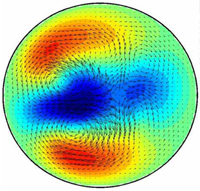Lagrangian measurements of inertial particle accelerations in shear, and in grid generated turbulence
26 mins 5 secs,
372.98 MB,
MPEG-4 Video
450x360,
25.0 fps,
44100 Hz,
1.9 Mbits/sec
Share this media item:
Embed this media item:
Embed this media item:
About this item

| Description: |
Warhaft, Z (Cornell)
Wednesday 10 September 2008, 10:20-10:40 |
|---|
| Created: | 2008-10-07 12:29 | ||||
|---|---|---|---|---|---|
| Collection: | The Nature of High Reynolds Number Turbulence | ||||
| Publisher: | Isaac Newton Institute | ||||
| Copyright: | Warhaft, Z | ||||
| Language: | eng (English) | ||||
| Distribution: |
World
|
||||
| Keywords: | Transition; Turbulence; | ||||
| Credits: |
|
||||
| Explicit content: | No | ||||
| Aspect Ratio: | 4:3 | ||||
| Screencast: | No | ||||
| Bumper: | /sms-ingest/static/new-4x3-bumper.dv | ||||
| Trailer: | /sms-ingest/static/new-4x3-trailer.dv | ||||
| Abstract: | We describe two dimensional Lagrangian acceleration statistics of inertial particles in a turbulent boundary layer and contrast the results with those observed in decaying grid generated turbulence (Ayyalasomayajula PRL .Vol. 97,144507 (2006)) . The statistics were determined by means of particle tracking techniques using a high speed camera moving along the side of a wind tunnel at the mean flow speed . Water droplets were fed into the flow using two different methods: sprays placed down-stream from an active grid, and from tubes fed into the boundary layer from humidifiers. The boundary layer, which had considerable free stream turbulence, was formed above a flat plate placed horizontally in the tunnel. The flows are described in terms of the Stokes, Froude and Reynolds numbers. For the flow conditions studied, the sprays produced Stokes numbers varying from 0.47 to 1.2, and the humidifiers produced Stokes numbers varying from 0.035 to 0.25, where the low and high values refer to the outer boundary layer edge and the near-wall region, respectively. The Froude number was approximately 1.0 for the sprays and 0.25 for the humidifiers. The boundary layer momentum thickness Reynolds number was approximately 800. The free stream turbulence was varied by operating the grid in the active mode as well as a passive mode (the latter behaves as a conventional grid). The effects of the free stream turbulence on the acceleration statistics were systematically studied. At the outer edge of the boundary layer, where the shear was weak, the acceleration probability density functions were similar to those previously observed in isotropic turbulence for inertial particles. As the boundary layer plate was approached, the tails of the probability density functions narrowed, became negatively skewed, and their peak occurred at negative accelerations (decelerations in the stream-wise direction). The mean deceleration and its rms increased to large values close to the plate. These effects were more pronounced at higher Stokes number. Although there were free stream turbulence effects, and the complex boundary layer structure played an important role, a simple model suggests that the acceleration behavior is dominated by shear and inertia. The results are contrasted with inertial particles in isotropic turbulence and with fluid particle acceleration statistics in a boundary layer. The work was supported by the US National Science Foundation.
A seminar from the Wall Bounded Shear Flows: Transition and Turbulence conference in association with the Newton Institute programme: The Nature of High Reynolds Number Turbulence www.newton.ac.uk/programmes/HRT/seminars/ |
|---|---|
Available Formats
| Format | Quality | Bitrate | Size | |||
|---|---|---|---|---|---|---|
| MPEG-4 Video * | 450x360 | 1.9 Mbits/sec | 372.98 MB | View | Download | |
| WebM | 450x360 | 749.85 kbits/sec | 143.34 MB | View | Download | |
| Flash Video | 480x360 | 802.94 kbits/sec | 154.96 MB | View | Download | |
| iPod Video | 480x360 | 502.34 kbits/sec | 96.95 MB | View | Download | |
| QuickTime | 384x288 | 842.84 kbits/sec | 162.66 MB | View | Download | |
| MP3 | 44100 Hz | 125.03 kbits/sec | 23.76 MB | Listen | Download | |
| Windows Media Video | 474.41 kbits/sec | 91.56 MB | View | Download | ||
| Auto | (Allows browser to choose a format it supports) | |||||

